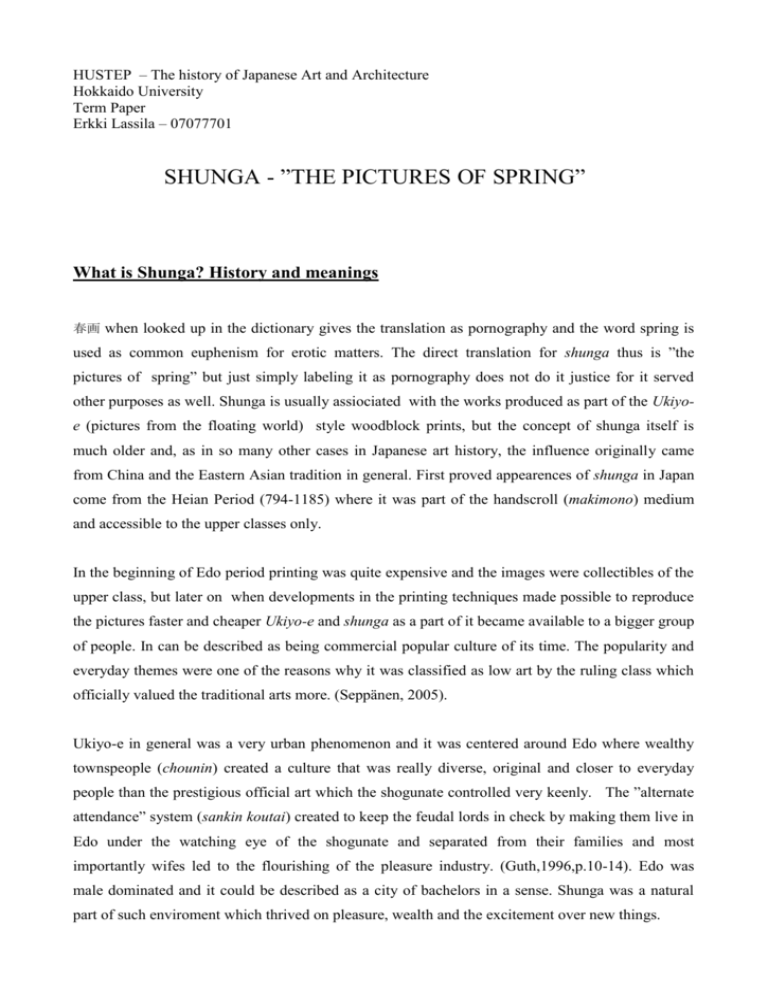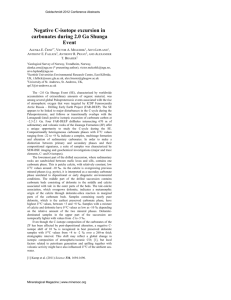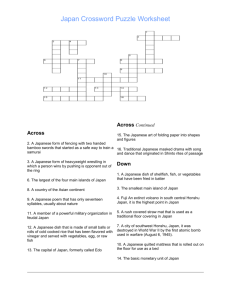
HUSTEP – The history of Japanese Art and Architecture
Hokkaido University
Term Paper
Erkki Lassila – 07077701
SHUNGA - ”THE PICTURES OF SPRING”
What is Shunga? History and meanings
春画 when looked up in the dictionary gives the translation as pornography and the word spring is
used as common euphenism for erotic matters. The direct translation for shunga thus is ”the
pictures of spring” but just simply labeling it as pornography does not do it justice for it served
other purposes as well. Shunga is usually assiociated with the works produced as part of the Ukiyoe (pictures from the floating world) style woodblock prints, but the concept of shunga itself is
much older and, as in so many other cases in Japanese art history, the influence originally came
from China and the Eastern Asian tradition in general. First proved appearences of shunga in Japan
come from the Heian Period (794-1185) where it was part of the handscroll (makimono) medium
and accessible to the upper classes only.
In the beginning of Edo period printing was quite expensive and the images were collectibles of the
upper class, but later on when developments in the printing techniques made possible to reproduce
the pictures faster and cheaper Ukiyo-e and shunga as a part of it became available to a bigger group
of people. In can be described as being commercial popular culture of its time. The popularity and
everyday themes were one of the reasons why it was classified as low art by the ruling class which
officially valued the traditional arts more. (Seppänen, 2005).
Ukiyo-e in general was a very urban phenomenon and it was centered around Edo where wealthy
townspeople (chounin) created a culture that was really diverse, original and closer to everyday
people than the prestigious official art which the shogunate controlled very keenly. The ”alternate
attendance” system (sankin koutai) created to keep the feudal lords in check by making them live in
Edo under the watching eye of the shogunate and separated from their families and most
importantly wifes led to the flourishing of the pleasure industry. (Guth,1996,p.10-14). Edo was
male dominated and it could be described as a city of bachelors in a sense. Shunga was a natural
part of such enviroment which thrived on pleasure, wealth and the excitement over new things.
Even though ukiyo-e was featured most prominently in Edo it doesn't mean that it was a
phenomenom exclusive to it only. Shunga works were also created in the Kansai region, Osaka and
Kyoto, and the moods and tones of the works were different from those created in the capital. The
pictures of Kyoto based artists were typically more graceful and closer to traditional ideals as is
fitting for the long standing cultural capital.
Shunga prints were produced and sold either as single sheets or - more frequently - in book form,
called enpon. Makura-e (pillow pictures) was used as a more mellow term to describe shunga and
in those cases was usually in a book form which meant basically linking the pictures with
accompanying erotic stories. Different names used about shunga tell a lot on how it might have
been viewed and what kind of meanings it has held in it's time. Osoku-zu meaning men and women
sleeping in the same bed but to also pictures that relax the mind implies that they served a
recreational purpose bringing joy to the viewee. The term nure-e, the wet pictures, was also used.
Warai-e or the pictures for laughing, suggests that the Japanese people saw sex and sexuality as
mostly positive thing and many shunga pictures show a touch of warm humor. (Seppänen, 2005).
Shunga has also played a role in the Japanese superstitious traditions:
”Japan has a strong tradition of erotica and its people have held various associated beliefs. In the
Japanese middle ages, the samurai believed that sex would safeguard them against misfortune. It
was widely believed in the Edo period that placing a shunga in a building would provide protection
against fire and as late as the Russo-Japanese War (1904–1905) soldiers carried erotic books with
them as good-luck charms.”
Quote from the Helsinki Art Museum description on their shunga exhibition.
Who created shunga works?
Most of the notable Ukiyo-e artist of the times also created prints of strong sexual content that falls
into shunga category. The praised masters like Hokusai, Utamaro and such tried their skills on such
material. One reason might be that doing shunga was quite profitable because of high demand of
such material at the time. Some estimates say that artist could live for six months out from the
payment received from doing one work. The thing to note is that this did not stain their artistic
image or prestige. One reason for that might be that they were usually published under pseudonyms
and did not have the signatures and seals as other works usually did. The works could be attributed
to individual artists through similar styles of execution and the secret names that they used.
Anonymity was a way of protecting against legal actions on publishing of such material even
though the restrictions were not usually very strict and implemented quite loosely.
High demand was of course not the only reason for artists to produce works on sexual matters and
quite often the makers were interested in the topic either as a general and natural aspect of life or
with special hedonistic interestest which was quite typical to people of that time. For example the
works of Sugimura Jihei show the lines expressing the involvement and delight the artist
experienced when working with the subject. (Evans, 1979,p.119).
On some occasions it was hard to determine the maker as some works which were made out of
twelve prints had signature in only one work and some might have been credited to a figurehead of
certain time instead of the nameless apprentices of artistic school. This was many times the case
with works credited to master of the first generation of Ukiyo-e in late seventeenth century called
Hishikawa Moronobu (?-1694). (Evans, 1979, p.103).
Subject matters and stylistic features
One of the most instantly recognisable feature of the shunga pictures for the western eye that is
traditionally used to very naturalistic expression are the hugely exagerrated proportions of the
genitalia. One of the reasons given was the small size of the prints which required the areas of
interest either to educational or recreational means to be larger than normal to be viewable. (Kucera,
2004). Secondly it is possibly related to the long tradition of fertility rites and symbols in the east
and especially phallic worship (for an example of todays society see the kanamara matsuri).
Thirdly it might have something to do with the concepts of tatemae (the public self, outer image)
and honne (the real self, true feelings) where the normal face would represent the tatemae side
(”public face”) and the genitals (”the intimate face”) the the honne side of a person. This way of
contrasting the public against the private creates certain deeper tension to some of the shunga
works. (Kortelainen, 2004, p. 96).
The huge size of genitalia was no new invention in Japanese art and the shunga artists who used the
feature were actually following a well established convention. Passage from a manuscript called
Kokun chomunju made in the mid -thirteenth century mentions this in a discussion between master
and his students .(Evans, 1979, p.78).
The awkward and sometimes utterly impossible poses were mainly due to the fact that the prints
were exlusively a two-dimensional format and the flat surface demanded distortion of the bodies to
depict the activity. It stands somewhere in between the mimetic (natural imitation) and purely
expressive art forms. (Evans,215&220).
Instead of a realistic description of the sexual traditions or instructions of the contemporary time
shunga was more of a sensual dream; a product illustrating of happiness and success that you could
purchase. (Ibid, p.93). Shunga and porn today have simalarities in that sense with the exception that
the latter lacks the life-affirming humour approach. Some shunga pictures were used as illustrations
in sex education materials where they typically accompanied old Chinese teachings of the sensual
matters or the pillow books of Yoshikawa pleasure district. What was labeled as sex education
material was completely different from its western counterparts which did not exist during those
days. It was more of a sexual astrology than explanations on biological or psychologial terms.
(Evans, 1979, p.103).
When it comes subject matters and drawing styles shunga was really varied. The moods and themes
ranged from happy and humorous to extremely aggresive and violent. Works from early Edo-period
tend to be more romantic while later works developed more rough and cynical style which implies
that chronological changing occured. (Kortelainen, p.94). One work of credited to Hokusai, usually
called ”The Dream of The Fishermans Wife” where a woman is engaged in sexual activity with an
octopus, is interesting if in nothing else but showing how much more open minded the Japanese
culture used be towards sexual topics before Meiji Restauration. The infamous tantacles of hentaianimation didn't come out of nowhere and judging by the old stories gathered in the book Shunga –
The essence of Japanese pillow- book eroticism tales involving other just sex between humans is
part of an older tradition. In the same book is a short version of an old Japanese myth which tells a
story of Ama-no-Uzume, a goddess who possessed an extreme sexual appetite and competed with
the Goddess Of the Sun
Amaterasu
herself
(Norton, 2002, p. 14-19)
In the pictures the social status and other relevant factors to understanding the pictures were in
many cases shown through the clothing worn by the participants, the surrounding environment and
different symbols (Seppänen, 2005). In the rare pictures of masturbating women the missing man
might be represented by a sword in the backgroung for example. The fact that in most shunga
pictures the fictional people are almost always nearly fully clad in clothes does not have anything to
do with shame but instead it was consired to be more aestethically pleasing and erotically
interesting than completely naked bodies (Kortelainen, 2004, p. 96).
Images with group activities are often seen which tell of totally different attitude towards sex than
Western people have been used to. This could be credited to self-confidence and lack of inhibitions
opposed to Western cultures secrecy and privacy which did not really exist in Japan those days. At
the same vein works with a third party watching the scene are quite common as it must have been in
real life too in a land where people live close to each other with minimal or no privacy at all. As an
artistic tool it works as an entry point for the one watching the picture and offers a chance to
identify more stronger with the scene as a voyeur. (Evans, p.120& 184).
Art or porn? - Cencorship issues
Many people are keen on labeling shunga as cheap and crude pornography on first sight and that
was often the case when Western scholars evaluated the works along with the other prints. They
were rarely seen equal to other output of the artist which the Evans see being very odd as it is not
very reasonable to suggest that the genious the artist possess suddenly dissappears when he starts
depicting sexual acts. Japanese themselves didnnot see any problems and such interpretations and
prejudices exist clearly only in the minds of Westeners who have been brought up with different set
of moral values on life and sex. (Evans, p. 132).
The fundamental difference between art and porn lies in the basic intention and the relationship to
standards of social behavior and human qualities. Porn is exploitative by nature and procuded
mainly to make money and provide those who cannot enjoy sex in its normal form an opportunity to
fulfill sexual needs. Shunga was different as it was a natural extension to the sexual life of its time
and allowed for the artists to find out importants facts of the human condition. (Evans, p.12).
The attitude towards shunga works and towards sexuality in general was really open minded and
the ruling class allowed it to exist without much interruption, but when the Western ideals and
morals were introduced to the system that had been isolated from the world for a long time, things
began to change.
The question whether shunga should be consired as seriously taken art or just
disposable pornographic material is an issue of debate and ties to the Japanese cencorship laws. The
old shunga works are generally consired to be legitimate art as part of the Ykiyo-e style which
needed the support of European collectors to gain that status (Kortelainen, 2004, p.104). The
pictures are not naturally produced anymore but their reprinting in artbooks is controlled and the
genital areas are usually cencored by covering them with color spots (Ibid, p.104).
Because of difficulties in cencoring different works the general Japanese guideline has been that the
pubic hair is not allowed to be shown. The laws are complex and a seemingly incoherent mixture of
both Japanese and Western traditions of sexual moralization. Shunga books with uncencored
pictures cannot be printed or sold in Japan today. There is also difficulty of separating shunga from
the rest of the Ukiyo-e works because they were usually made by the same artists who did the nonerotic prints as mentioned before.
Shunga along with other medias that could stimulate the imagination or give people strong sexual
appetites were consired to be a threat to social stability and were essentially against the Confucian
ethic teaching which the ruling shogunate gave great importance (Guth, p.28). The rulers were keen
to keep ”dangerous arts” in close monitoring but shunga was rarely heavily targeted because kabuki
theatre with its sexual role reversals (onnagata) was seen as a bigger threath. (Guth, p.32)
Art historical significance
As was case with ukiyo-e also shunga was consired to be lower art partly due to its popularity and it
took time for it to get recognition in Japan. European art connesseurs on the other hand recognized
its uniqueness a lot faster and where buying of the original prints in an alarming rate. The works are
integral part of the unique urban culture of time giving as a glimpse of the lives and thoughts of the
people of that time, even though just the pictures by themselves do not give a good picture of the
time of their creation. But if one was to ignore shunga altogether the image we have of Edo period
and their people would be insufficient. It is a testament to time when art, sexuality and society were
virtually inseparatable.
Ukiyo-e is important for introducing the commercial and mass produced art to Japan which brought
the art to the grasp of the common people for the first time in the long history of Japanese art. The
shunga print works were in a way very modern when it comes to the way they were produced and
marketed but still managed to retain the Japanese style reflecting the traditional aesthetic standards
for most parts even though the subject matters were greatly different from those of the classic
paintings. (Nash, E. 2004).
Shunga is also uniquely different from most Eastern erotic art as it is neither religious or
philosophical by its nature and Japan is the only country where eroticism has been such a widely
acceptable subject for secular (earthly) art. One must also not forget that shunga had a great impact
on Western artists when the prints arrived to Europe with the opening of Japan after Meiji
Restoration affecting the works of such names as Van Gogh, Monet and Gauguin. (Evens, 1979,
p.10&41)
References:
Evans, T.&M.A. Shunga – The art of love in Japan. 1979. Paddington Press Ltd. London.
Guth, C. Art of Edo Japan - The artist and the city1615-1868.1996.
Kortelainen, Anna. ”Säädyttömyyden vaihtokauppaa: Geisha, shunga ja sensuuri”. Japanilainen
nainen: kuvissa ja kuvien takana, s.89-111. Compiled by Annamari Konttinen and Seija Jalagin.
Suomen Japanin
Instituutti.Vastapaino. Tampere 2004.Kucera, Greg. Japanese Shunga.
(http://www.gregkucera.com/shunga.htm)
Nash, E. Edo Print Art and its Western interpretations. University of Maryland. 2004
Norton, B. Shunga- The Essence of Japanese Pillow-Book Eroticism. Astrolog Publishing
house.2002. ISBN 965-949-144-9
Seppänen, J. Leijuvan maailman keväisiä kuvia – Ukiyo-e-shunga, Japanin Edo-kauden
puupiirrostaide, Harukaze – Publication of Japan Studies in the University of Oulu. 2005.









